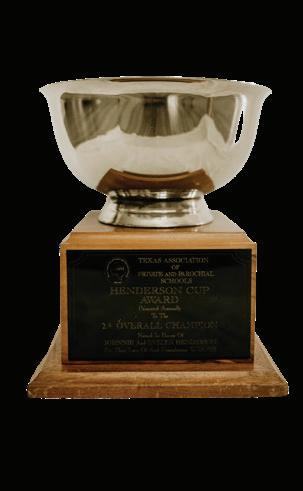CATCHME WITH DVORAK












Thank you for joining us for our fifth Masterworks concert of the 2022-23 season, “Catch Me With Dvořák”! Tonight’s performance will prove exhilarating with John Williams’ “Escapades” from the film “Catch Me If You Can,” along with Williams’ Tuba Concerto, and the work voted Lubbock’s favorite symphonic work, Dvořák’s “New World” Symphony. We are joined tonight by guest conductor Christopher Zimmerman of the Fairfax and Fargo-Moorhead Symphony Orchestras. We are thrilled to welcome Maestro Zimmerman to Lubbock for this special appearance.
We want to extend our deepest appreciation to The United Family for sponsoring tonight’s concert. Their partnership has continued to grow with us, and for that, we are very thankful. To all our sponsors, thank you for your continued incredible support of the Lubbock Symphony.
Our next performance, the “Spring SOUND! Chamber” concert on March 21st, will broaden your musical horizons with “Lucky Sevens,” curated by our ClefNotes and SiriusXM Symphony Hall host John Clare. We’ll hear the music of Beethoven, Saint-Saëns, John Adams, and Kevin Puts. You won’t want to miss this fantastic event!
Galen Wixson President and CEO Lubbock Symphony Orchestra

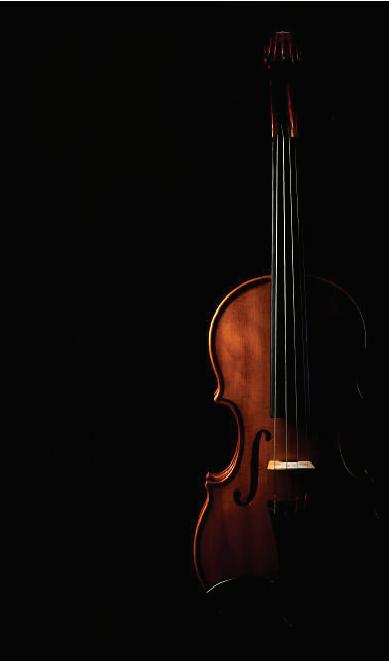


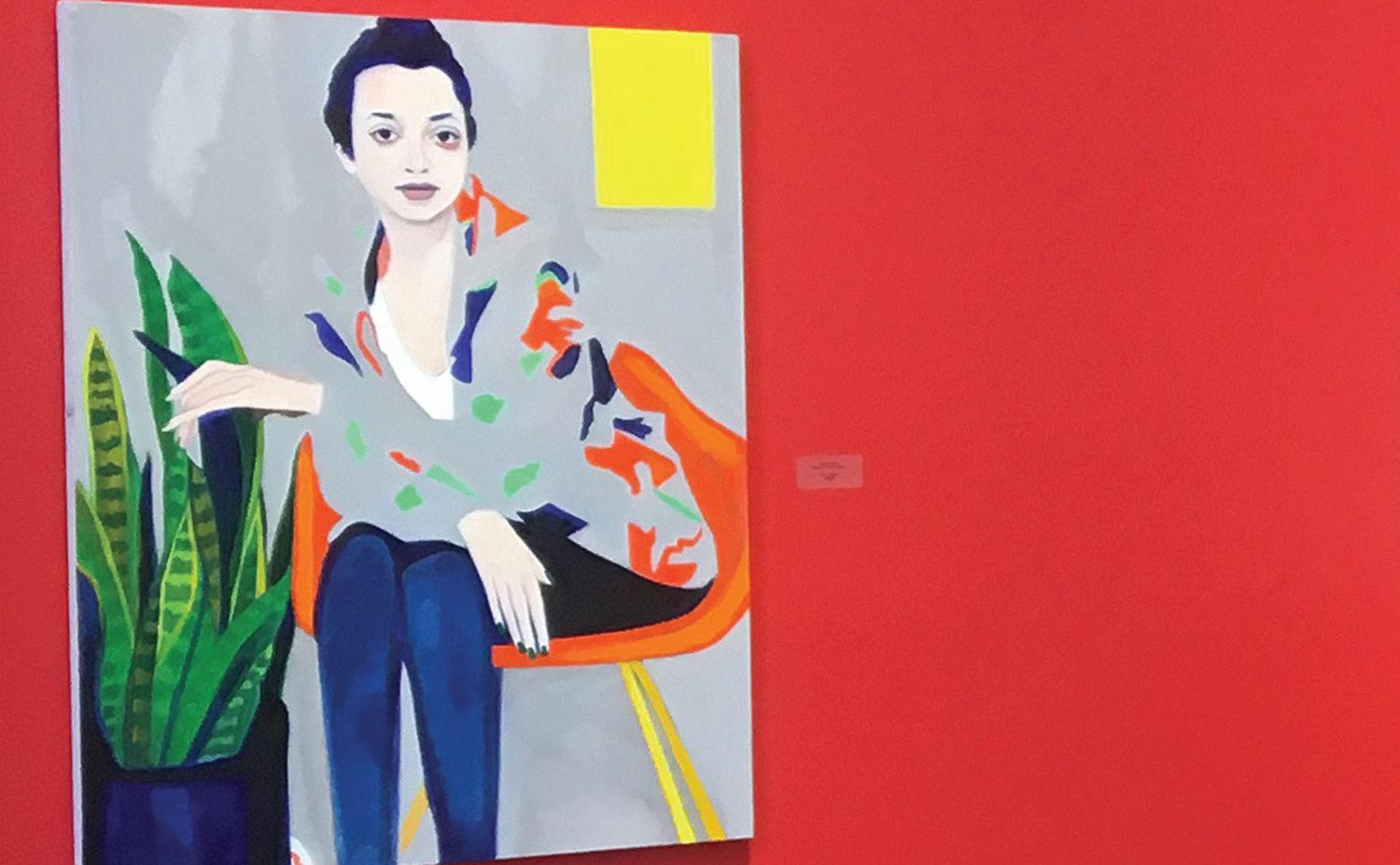



Tonight the LSO celebrates the retirement of Bassist Boyce Wyrick.
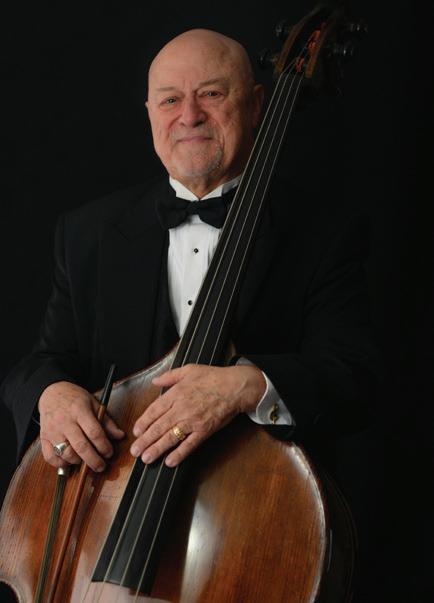
Wyrick attended school in Amarillo having attended Bowie MS and Caprock HS and performed in both the AllState Band and Orchestra. He holds two degrees from Texas Tech between serving as an Army Bandsman.
While teaching at Lubbock and Coronado high schools (35 years), Boyce was a member of Texas Music Educators, Texas Orchestra Directors, Texas Music Adjudicators, and Mu Omicron. He maintains membership in the International Society of Bassists (ISB). He went on to serve as an adjunct at Wayland Baptist (PLV). He was awarded the TODA Orchestra Director of the Year in 2010. Wyrick is especially proud of the many students he taught and their accomplishments.
He guest conducted All-Region HS orchestras in Amarillo, San Angelo, Midland, Odessa, Abilene, Wichita Falls, Arlington, Tyler, San Antonio, and El Paso. Wyrick conducted the Plainview Symphony for a number of seasons.

In addition to his years with the Lubbock Symphony he has played in Amarillo, Midland-Odessa, Roswell, San Antonio (Civic), Seoul and Yongsan (ROK), Lawton (OK), San Angelo, Plainview, and Fairbanks. While in the LSO, Boyce served on the Policies and Procedure Committee and as Personnel Manager.
Leaving LSO he will continue as music director at Westminster Presbyterian Church where he has served for 25 years.
Boyce and Kathy have four children, nine grandchildren and one soon-toarrive great grandchild (Milo). Along with his family and friends, his two sisters, Pam and Karla are in attendance tonight.
Thank you, Lubbock Symphony … I’ll miss you!
In honor of William A. Harrod
Founding Conductor of the Lubbock Symphony Orchestra, 1946-1987


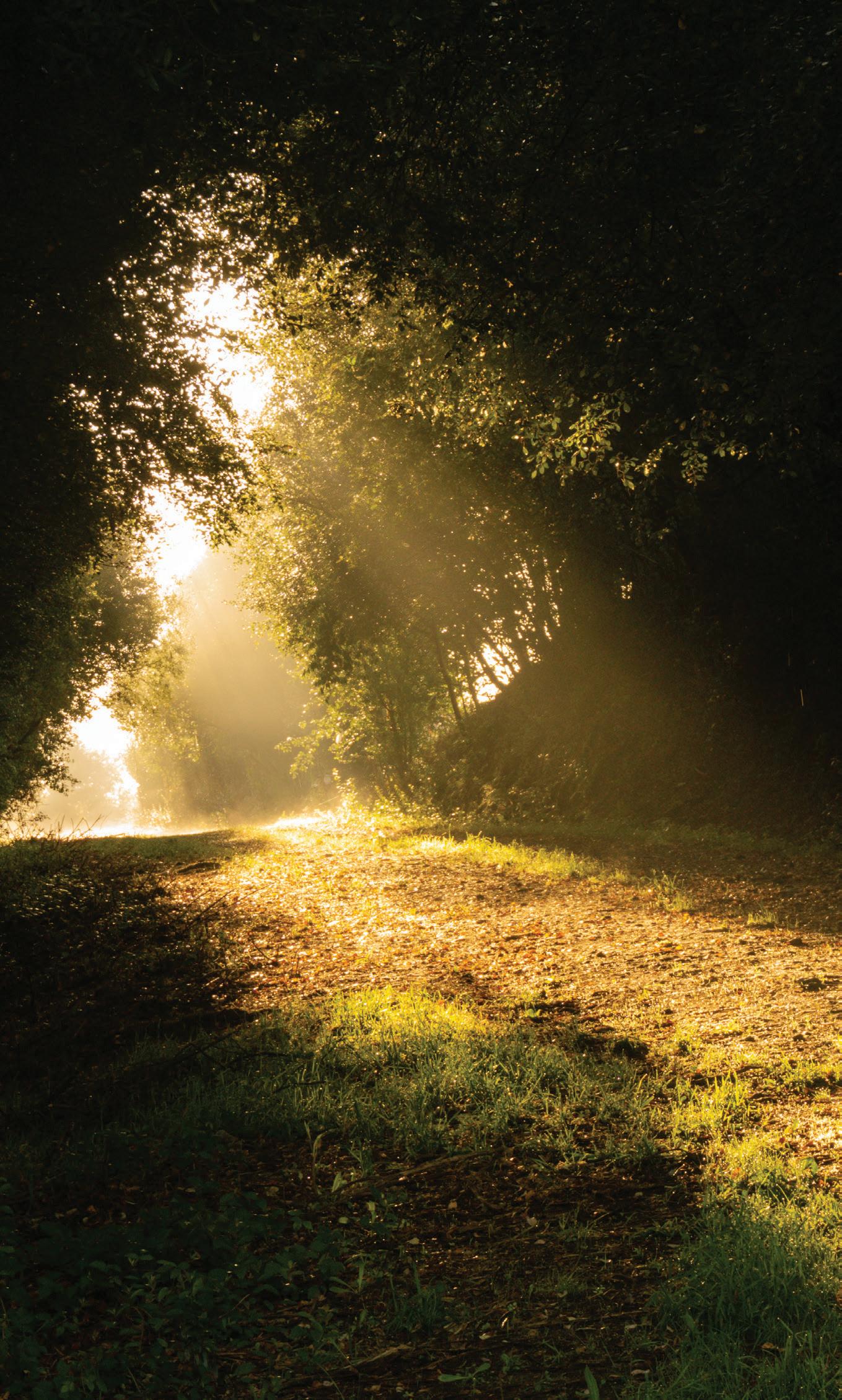
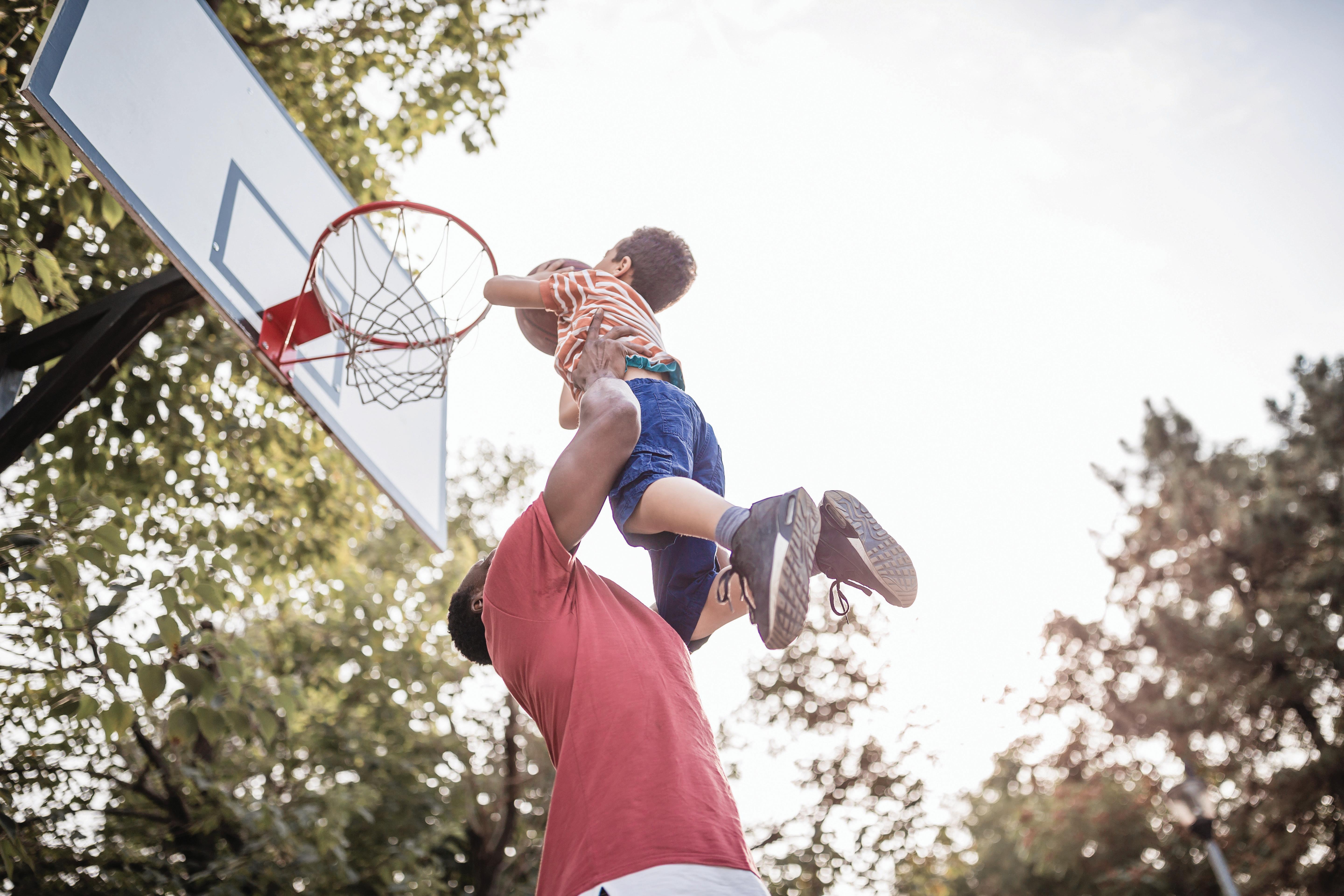



Christopher Zimmerman is currently celebrating his 12th season as Music Director of the Fairfax, VA and his 9th of the Fargo-Moorhead, ND Symphony Orchestras.
Under his artistic leadership the Fairfax Symphony Orchestra has received consistent praise from the media. Recently, in 2019, Chief Critic of the Washington Post, Anne Midgette, commented: “I’ve said before that the Fairfax Symphony would be the jewel of many smaller communities. Its dynamic, capable music director, Christopher Zimmerman, assembles smart and distinctive programs... Zimmerman, an adroit conductor, keeps verve and interest in each concert”. Another Washington Post reporter, Stephen Brookes, commented: “Zimmerman has been injecting adrenalin into this ensemble…(and has) made the Fairfax players a serious force to be reckoned with.”
From 2013 to 2018 Zimmerman was the Principal Conductor of the American Youth Philharmonic Orchestra, and is now their Principal Guest Conductor. He has also been the Music Director of the Carvalho Festival in Brazil, and, closer to home, a regular guest conductor at the Summer Performing Arts Festival in Wintergreen, Virginia.
In 2018 Mr. Zimmerman was invited to Vietnam to conduct the Ho Chi Minh Symphony in Saigon and, in 2019, was re-invited to that orchestra as well as making his debut with the Vietnamese National Symphony in Hanoi.
Vietnam aside, Zimmerman has been engaged as a guest conductor all over the world, with the London Symphony, the Royal Philharmonic, the Prague Symphony, the Slovak Philharmonic, the Turku Philharmonic, the Seoul Philharmonic, the Mexico City Philharmonic, the Caracas Philharmonic, National Orchestra of Rio de Janeiro, the Shenzhen Symphony, and the Xiamen Symphony–to name a few.
A champion of contemporary music, Zimmerman has conducted over 40 premieres for orchestra by nationally and internationally recognized composers, many of which are World and U.S. premieres. He also enjoys presenting less “mainstream” orchestral concerts, often in collaboration with dance, theatre, and video.
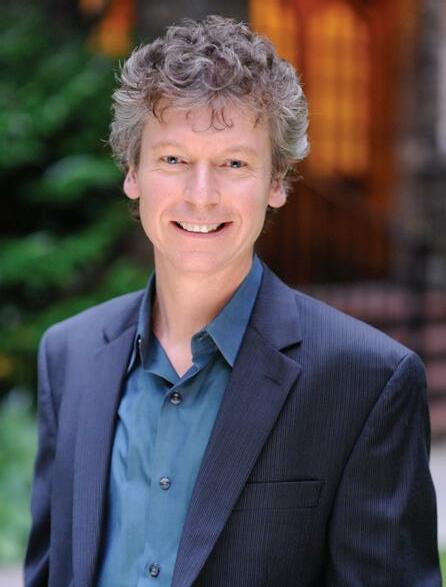
Under Zimmerman’s direction, the FSO was honored as the 2013 winner of Washington Area Music Award (WAMMIE) for best classical orchestra. In 2011, Zimmerman was selected as the first place winner in the professional orchestra category of “The American Prize in Conducting”, an award for nationwide performances for conductors of all genres and categories. His U.S. operatic conducting debut, of Carlisle Floyd’s “Susannah”, won first place in the National Opera Association competition, as did Bright Sheng’s “Song of Majnun”, which Zimmerman led two years later.
Christopher’s career has also embraced teaching and working with student orchestras and conductors; in 1993 he joined the conducting faculty at the College-Conservatory of Music in Cincinnati where he was Music Director of their concert orchestra, and in 1999 he was appointed Director of Orchestral Studies at the Hartt School as well as Music Director of the Hartt Symphony.
Christopher Zimmerman graduated from Yale University with a B.A. in Music, and received his Master’s degree in conducting from the University of Michigan under the tutelage of Gustav Meier. He studied with Seiji Ozawa and Gunther Schuller at Tanglewood and served as an apprentice to Andrew Davis and the Toronto Symphony, and subsequently as assistant conductor to Vaclav Neumann and the Czech Philharmonic Orchestra in Prague.





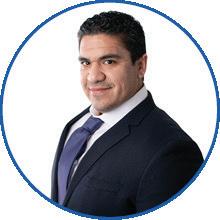
David Dees is Professor of Saxophone at Texas Tech University. He has been a prizewinner in national and international performance competitions and has performed throughout the USA and Europe and has served on the faculty of the Asia Pacific Saxophone Academy in Bangkok, Thailand. He served as host of the 2016 NASA Biennial (National) Conference held at Texas Tech University. His students were Gold Medalists in the Fischoff National Chamber Music Competition in 2015 and Grand Prize Winners in 2019. His primary saxophone studies have been with Debra Richtmeyer and Frederick Hemke. He is a recipient of the Texas Tech University’s Outstanding Faculty Award and is a member of the Texas Tech University Teaching Academy. Prior to joining the faculty at TTU, he was a saxophonist in the United States Army Band (Pershing’s Own) in Washington, D.C. He is an Artist / Clinician for Selmer Saxophones.
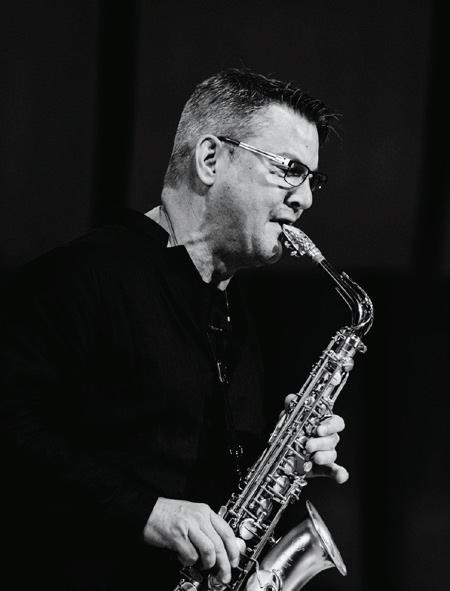
Lisa Rogers is Professor of Percussion Studies at Texas Tech University, where she teaches applied studies as well as directs ensembles such as the Texas Tech Steel Drum Band “Apocalypso Now.” She attended Texas State University and Texas Tech University for her undergraduate and graduate studies. Rogers received a DMA degree in percussion performance from the University of Oklahoma. She is a Past President of the Percussive Arts Society and currently Executive Director of the National Conference on Percussion Pedagogy. As an advocate of new literature for the vibraphone, she released a CD of solo works entitled “Paint Me a Sky” and has commissioned works including “Concerto for Vibraphone” by Nathan Daughtrey. Rogers also serves as Associate Research Editor for the Percussive Arts Society’s journal “Percussive Notes” and is Principal Timpanist of the Lubbock Symphony Orchestra.


You love Bach in black tie, but have you tried Sibelus in slippers? Beethoven à la bubble bath?
Dvořák with your favorite doggo?
Locally-curated classical content is now available via voice command— wherever you are. Just tell your smart device to play KTTZ-HD2, and start that soaker!


Kevin Wass is the Diekemper Family Foundation
Principal Tuba of the Lubbock Symphony Orchestra and Professor of Tuba and Euphonium at Texas Tech University. He has been a concerto soloist with the United States Army Orchestra and the Fountain City and Frontier Brass Bands and has appeared as a recitalist at more than 40 colleges and universities across the United States as well as at the Janáček Academy in Brno, Czechia, and the Madrid Royal Conservatory. He was an artist in residence at the Banff Centre for Arts and Creativity in 2015, studying contemporary performance practice and adapting Bach’s Solo Cello Suites for tuba. Ensemble credits include the Santa Fe Opera Orchestra, Santa Fe Pro Musica, and the West Texas, Honolulu, Omaha, and Lincoln symphonies. As a chamber musician, he currently performs with LSO Concertmaster Annie Chalex Boyle and his wife Susan Wass in the Durations Trio and is also the founding chair of the Collaborations Faculty Chamber Music Series at Texas Tech University. He holds degrees from the University of Michigan (DMA), Indiana University (MM and PC), and Dana




Christopher Zimmerman
The CH Foundation Endowed Conductor’s Podium
Annie Chalex Boyle
Concertmaster
Jones-Saathoff Family
Endowed Chair
Linda Lin
Associate Concertmaster
Diekemper Family Foundation
Endowed Chair
Maja Maklakiewicz
Abi Rhoades
Lazaro Gonzalez
Isaías Lopes Ferreira
Rodrigo Esteban Cardona
Francisco Villarroel
Judy Woody
Adan Flores
Kea Beasley
Lauren Pokorzynski
Principal
Justice Phil and Carla Johnson
Endowed Chair
Saikat Karmakar
Assistant Principal
Cassidy Forehand
Martha Perez
James Ellis
Shirley Wigley
Carroll Jane Goodyear
Texas Tech University School of Music
Endowed Performer
Lynn Ledbetter
Nilschmid Jimenez
Savannah Sharp
Philippe Chao
Principal
Mary M. Epps and Ralph E. Wallingford
Endowed Chair
Israel Mello

Sharon Mirll
Gwendolyn Matias-Ryan
Ryellen Joaquim
Marian Herrero
Brian Gum
Michael Newton
Principal
Mary Francis Carter Endowed Chair
Danny Mar
Alejos Anaya
Madeline Garcia
Neemias Santos
Daria MiŚkiewicz
Yuhan Shi
Anthony Newton
Mark Morton
Principal
Eugene and Covar Dabezies
Endowed Chair
Stuart Anderson
Boyce Wyrick
Griff Miller
Nodier Garcia
Zongyuan Wei
Flute
Kim Hudson
Principal
Crew of Columbia, STS-107
Endowed Chair
Eric Leise
Spencer Hartman
OBOE
Susetta Rockett
Principal
Lubbock Symphony Guild
Endowed Chair
Alex Hyde
ENGLISH Horn
Bethany Ham
Janeen Drew Holmes
Endowed Chair
Clarinet
David Shea
Principal
Christine Polvado and John Stockdale Endowed Chair
Trisha Burrell
Bass Clarinet
Mia Zamora
Alto Sax
Ryan Montemayor
Tenor Sax
Natalie Wilson
BASSOON
Vince Ocampo
Principal
Nancy and Tom Neal Endowed Chair
Adam Drake
Horn
Yu-hsuan Chang
Principal
Anthony and Helen Brittin
Endowed Chair
David Lewis
Lucian Hutchinson
John Stacy
Jack Mellinger
TRUMPET
Gary Hudson
Principal
Stacey and Robert Kollman Family Endowed Chair
Joe Vandiver
Zach Worley
Trombone
Bruce Keeling
Principal
Larry and Lucy Landusky
Endowed Chair
Haotian Quan
bass Trombone
Darin Cash
Tim and Mary Jane Sampson
Endowed Chair
Tuba
Christian Bush Principal
Diekemper Family Foundation
Endowed Chair
TIMPANI
Lisa Rogers
Principal
Lubbock Symphony Guild
Endowed Chair
percussion
Erin Martysz
Principal
Lisa Rogers/Alan Shinn
Endowed Chair
Michael Mixtacki
John Frederick
Taylor Burks
Joshua Watkins
Harp
Jennifer Miller Principal
Rachel Jean Armstrong Thomas
Endowed Chair
Keyboard
Richard Fountain Principal
Edward R. and Jo Anne M. Smith
Endowed Chair
LIBRARIAN
Vaughan Hennen

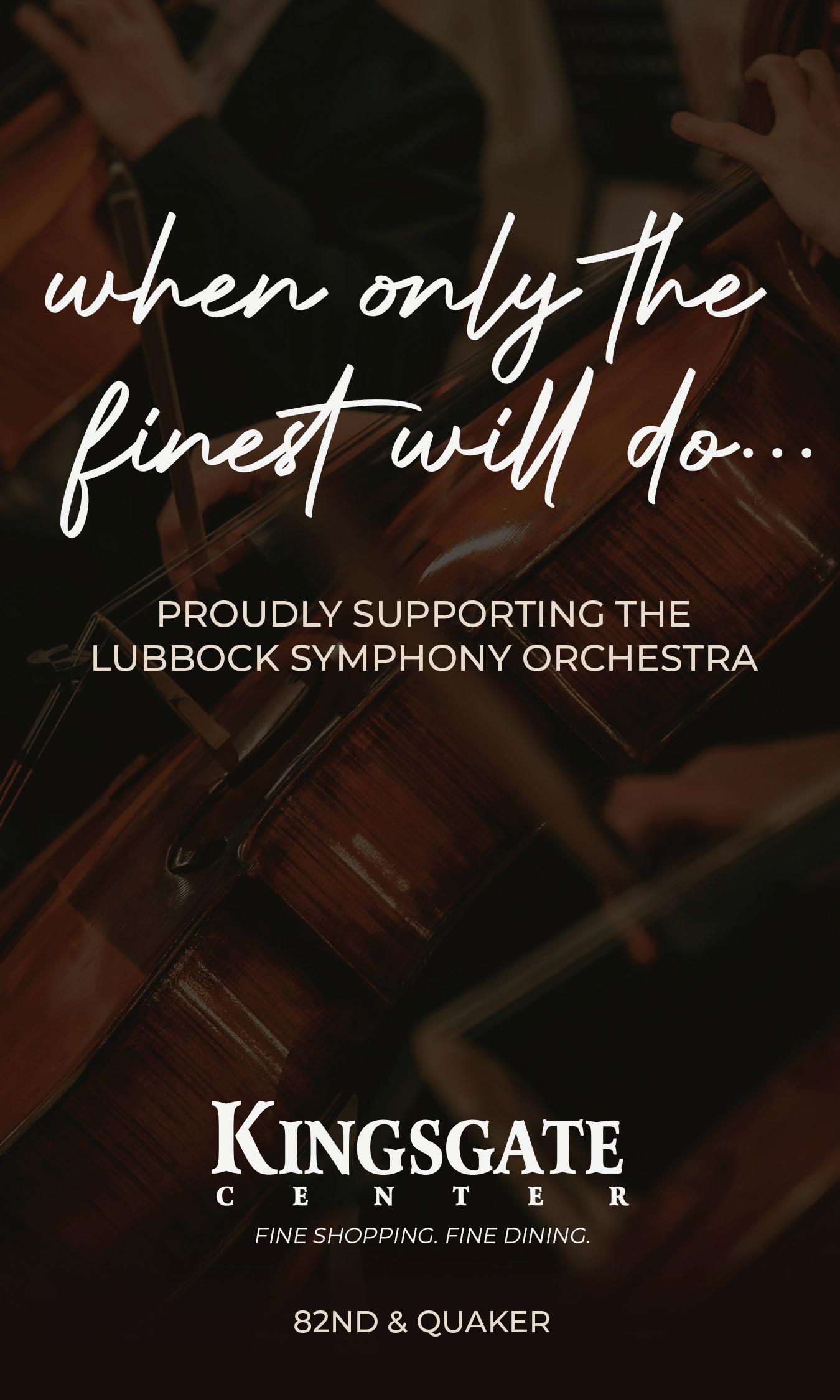



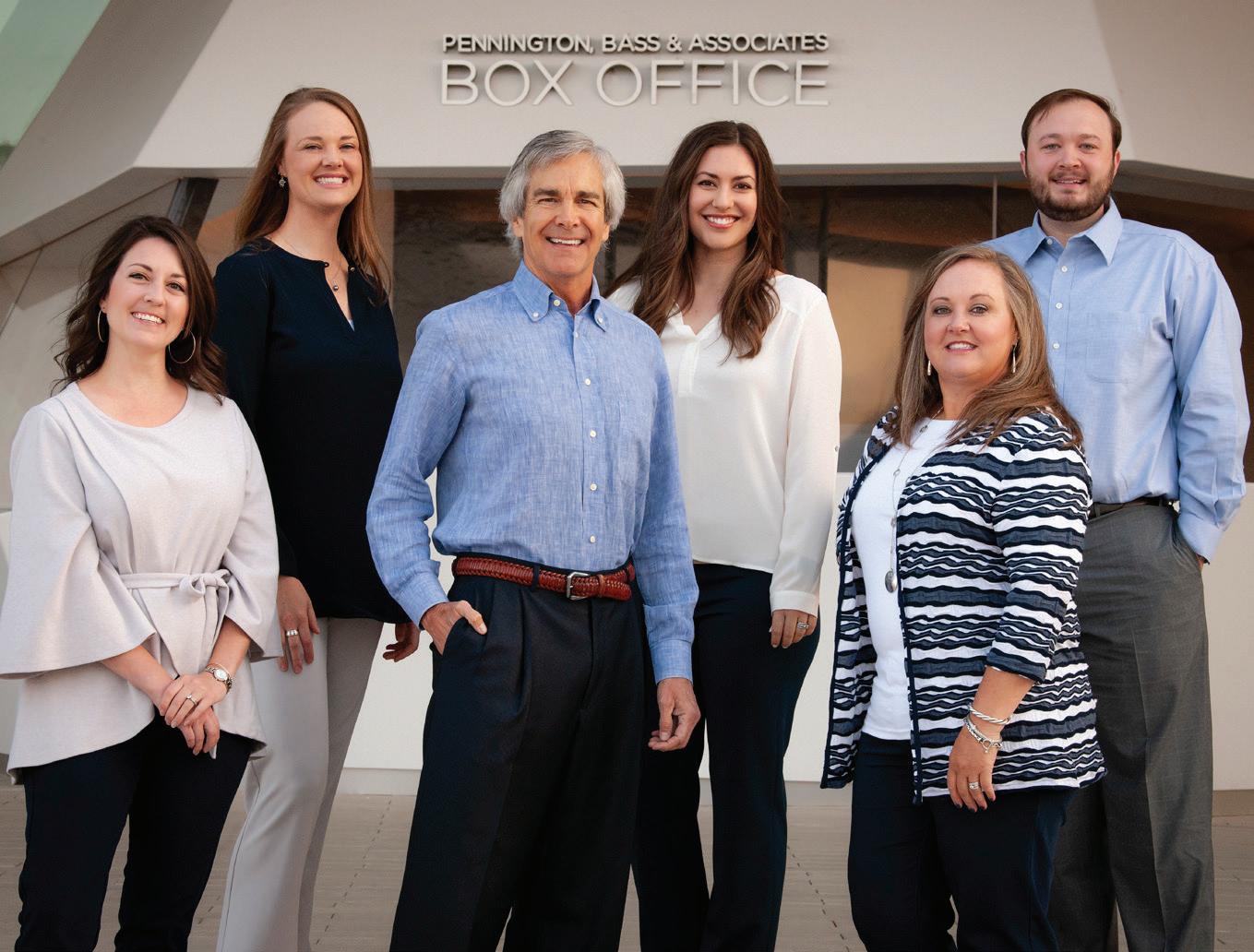
Escapades for Alto Saxophone & Orchestra | John Williams
The film “Catch Me If You Can” is based on the life of Frank Abagnale, Jr., a teenage forger, con man, and imposter.
Movement 1 “Closing In” – relates to the humorous sleuthing in the story.
Movement 2 “Reflections” – refers to the fragile relationships in Abagnale’s broken family.
Movement 3 “Joy Ride” – the music that accompanied Frank’s wild flights of fantasy that took him around the world before the law reined him in.
John Williams pays homage to the “cool jazz” style of the early 60s.
Concerto for Tuba & Orchestra | John Williams
This is Lubbock Symphony’s first time playing a Tuba Concerto!
It took nearly a century for composers to consider the tuba as a solo instrument.
John Williams composed the concerto exploring the wide range of the instrument and lighter melodic qualities, considering it “an agile instrument.”

Symphony No. 9 “From the New World” | Antonín Dvoˇrák
This piece was voted Lubbock’s favorite symphonic work!
As a Czech composer working in New York, Dvořák’s “From the New World” is his interpretation of American musical ideas through a Czech lens.
We hope you were able to participate in ClefNotes with John Clare prior to the concert this evening. John Clare will return to Lubbock as the curator for our “Spring SOUND! Chamber” on March 21st, themed around “Lucky Sevens.”
The first Native American to lead an all-classical radio station, John Nasukaluk Clare is comfortable behind a microphone, streaming video or playing violin. He is currently the Classical Music Director at WGUC in Cincinnati, and is the weekday morning drive host on SiriusXM’s Symphony Hall. In 2005, he earned the Deems Taylor Award from ASCAP for radio broadcasting, citing his work on 20/20 Hearing. An avid chamber music lover, Clare founded the Las Vegas Chamber Music Society in 2004.
Join us before “Carmen in Gold” for another beginner-friendly discussion with opera expert and LSO Board member Dr. Neil Kurtzman. 28
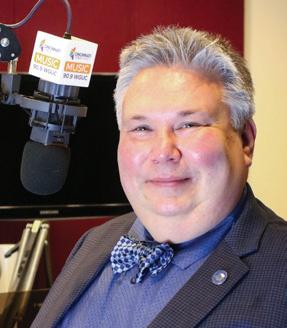
14 minutes
Escapades for Alto Saxophone & Orchestra, from “Catch Me If You Can” ..........................................John Williams (1932-)
I. Closing In
II. Reflections
III. Joy Ride
David Dees, alto saxophone Lisa Rogers, vibraphone
18 minutes
Concerto for Tuba & Orchestra............................John Williams (1932-)
I. Allegro moderato
II. Andante
III. Allegro molto
Kevin Wass, tuba
38 minutes
15 MINUTES
Symphony No. 9
“From the New World”..............................Antonín Dvořák (1841-1904)
I. Adagio – Allegro
II. Largo
III. Scherzo: Molto vivace
IV. Allegro con fuoco


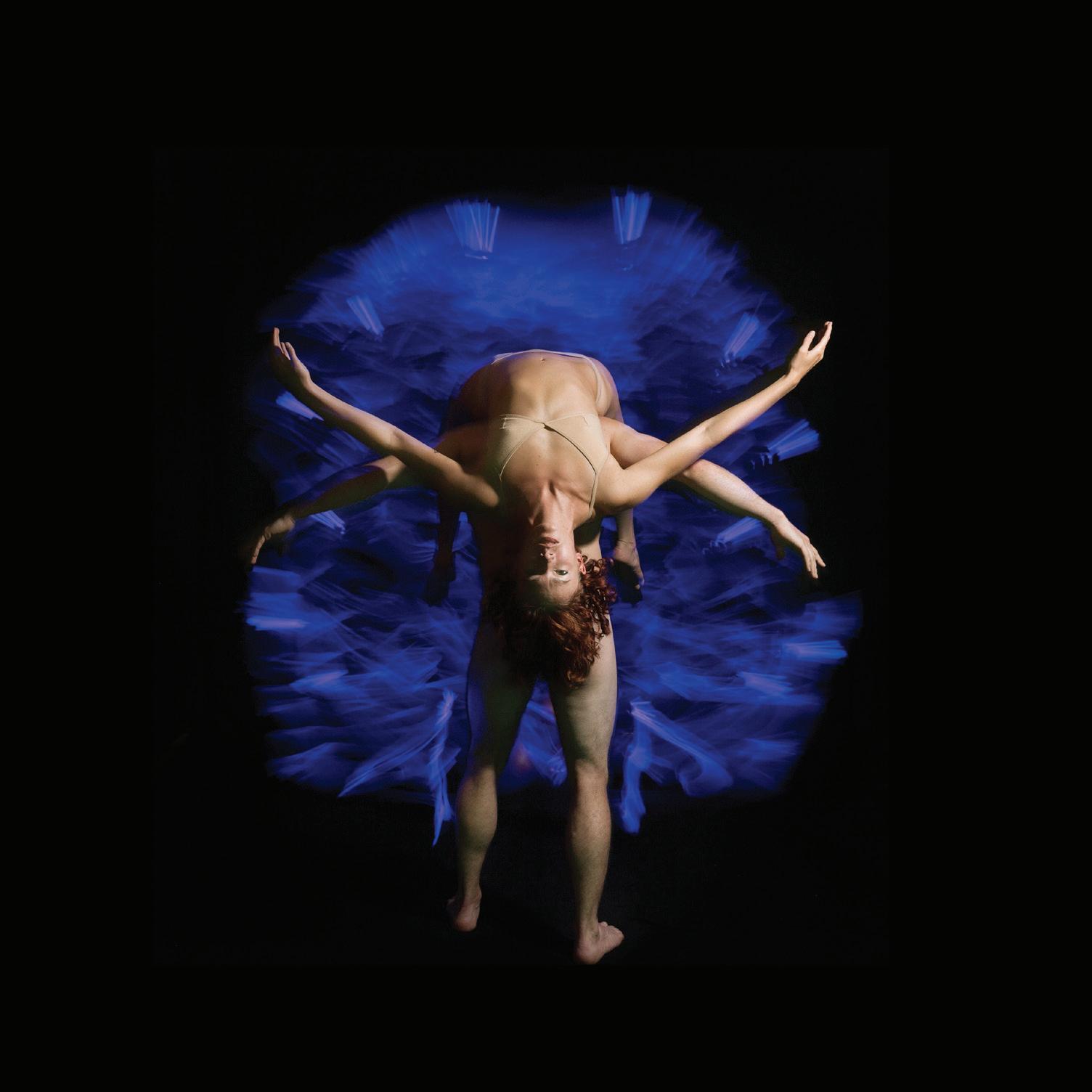
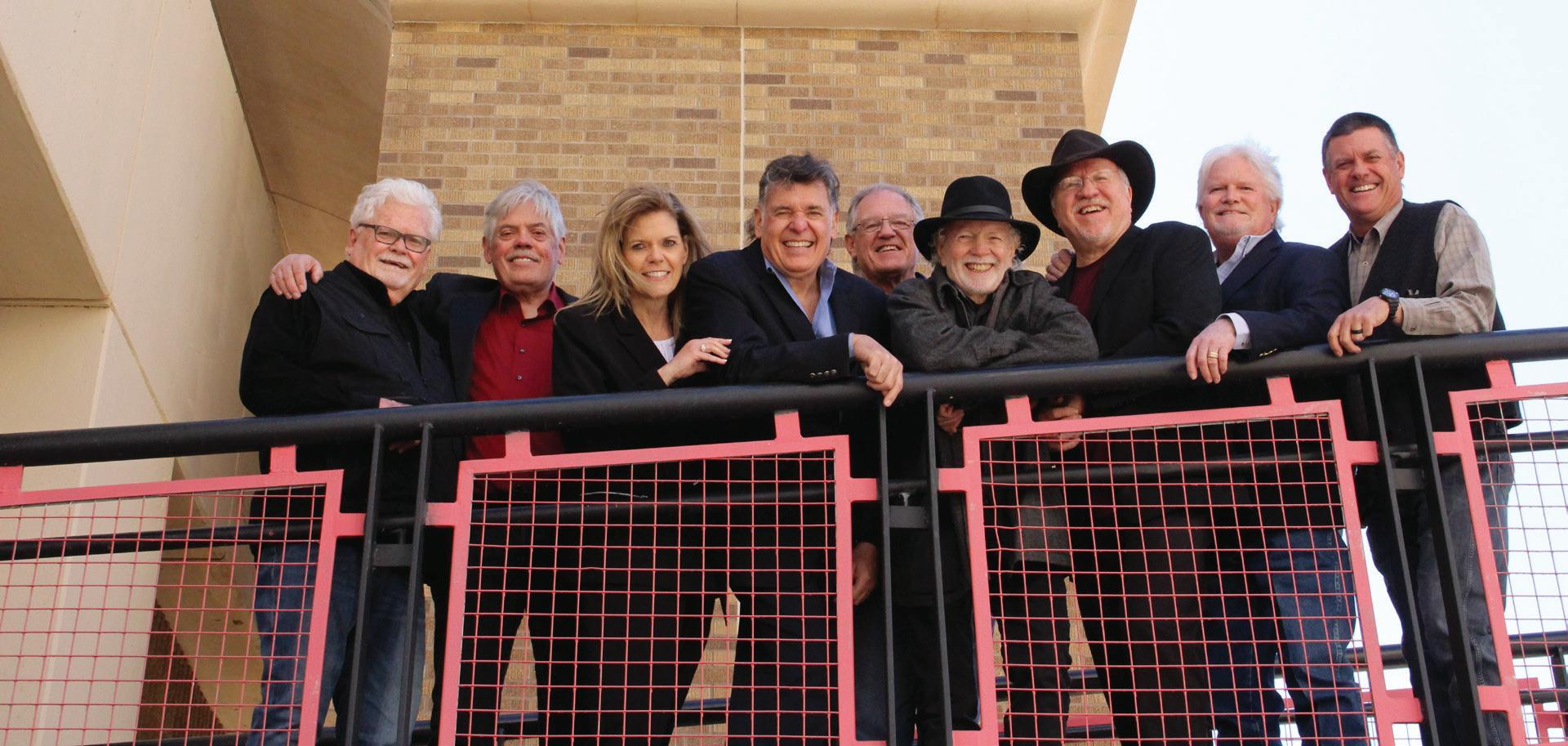


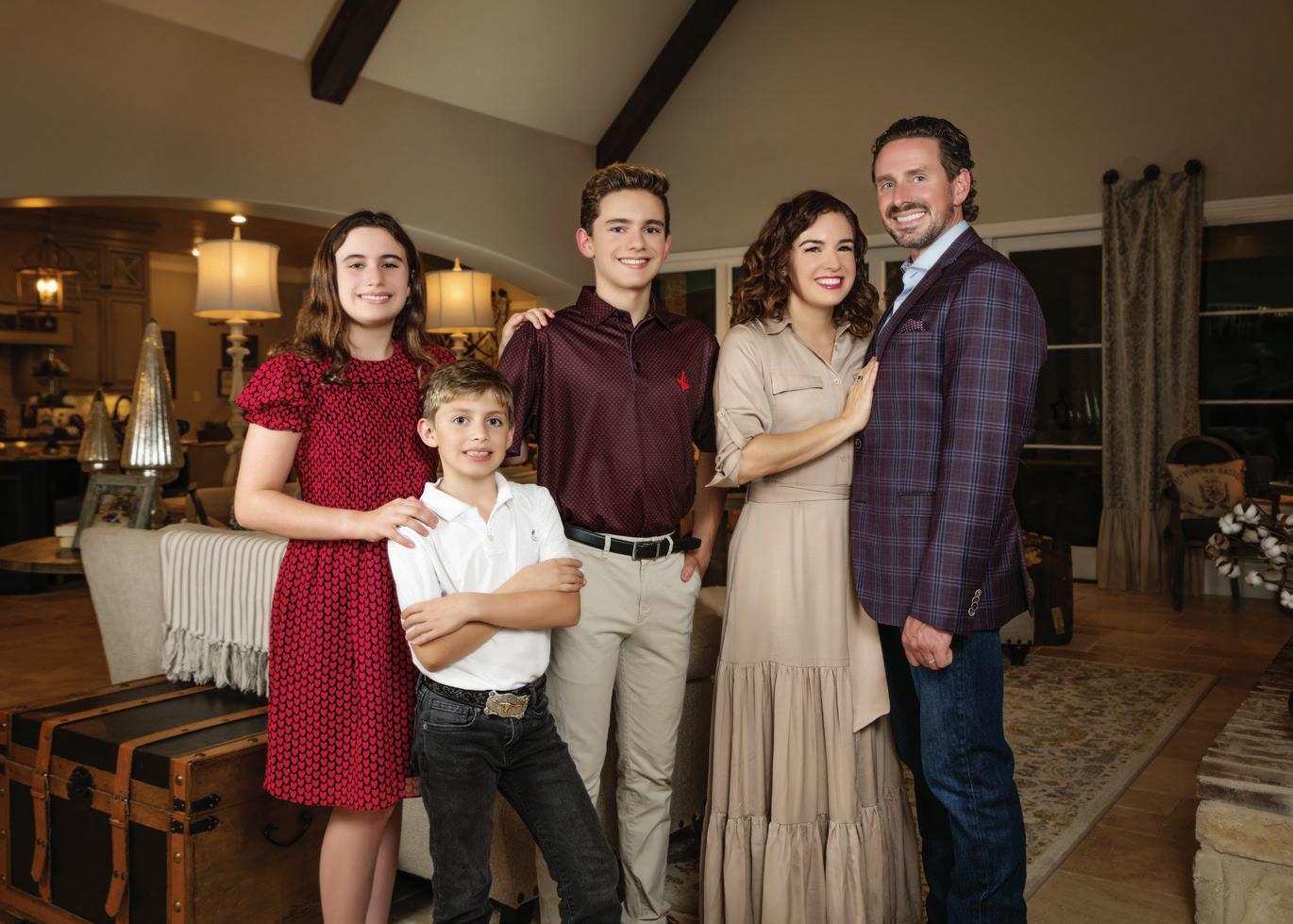
The 2002 Dreamworks film Catch Me If You Can is based upon the life and career of Frank Abagnale, Jr. (played by Leonardo DiCaprio), the teenage forger, con man, and imposter who is chased across the country and around the world by the check fraud division of the FBI, headed by agent Carl Hanratty (Tom Hanks). In the course of his crime spree, Abagnale impersonates an airline pilot, a doctor and a lawyer, and manages to elude Hanratty for over a decade until he is arrested by French authorities. Upon extradition to the United States, Abagnale joins forces with Hanratty and becomes one of the FBI’s foremost experts in bank fraud and check forgery.
John Williams’ score for the film pays homage to the “cool jazz” style of the early 1960s (the period in which the movie is set). With a prominent role in the score for the alto saxophone, it was a logical outgrowth of the movie to extract three concert excerpts that Williams entitled Escapades. The work is both a suite from the film and a concerto for saxophone and orchestra.
In the preface to the score, John Williams writes:
The film is set in the now nostalgically tinged 1960’s and so it seemed to me that I might evoke the atmosphere of that time by writing a sort of impressionistic memoir of the progressive jazz movement that was then so popular. The alto saxophone seemed the ideal vehicle for this expression and the three movements of this suite are the result.
In “Closing In,” we have music that relates to the often humorous sleuthing which took place in the story, followed by “Reflections,” which refers to the fragile relationships in Abagnale’s broken family. Finally, in “Joy Ride,” we have the music that accompanied Frank’s wild flights of fantasy that took him all around the world before the law finally reined him in.
In recording the soundtrack for this entertaining film, I had the services of saxophonist Dan Higgins, to whom I’m indebted for his virtuosic skill and beautiful sound. My greatest reward would be if other players of this elegant instrument might find some joy in this music.
Like the viola and the bassoon, the bass tuba could compete for the title of the “Rodney Dangerfield of the Orchestra” – it doesn’t get a lot of respect. But in our time, the tuba has gone from a musical joke to a musical powerhouse. Perhaps the reason that recognition has been slow in coming to this large and often ungainly instrument is that the tuba is only a recent invention.
There have been brass instruments capable of playing the bass lines throughout music history, transforming into their modern versions at the end of the Renaissance. The serpent, so named because of the undulating shape of its tubing, appeared at the end of the sixteenth century. Made of wood and

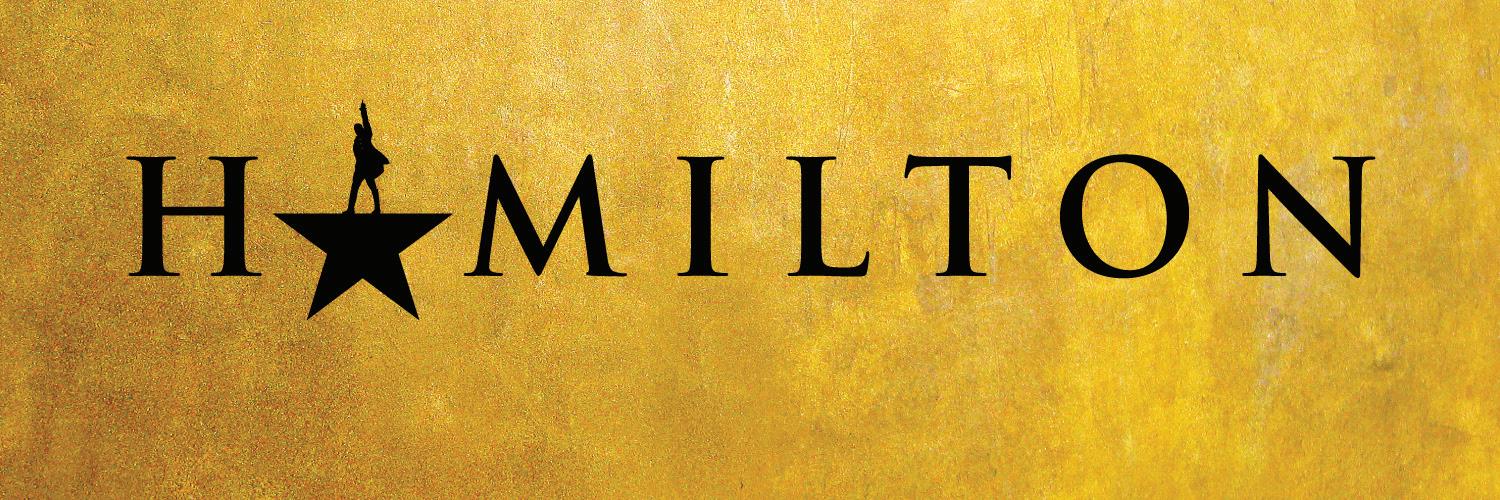
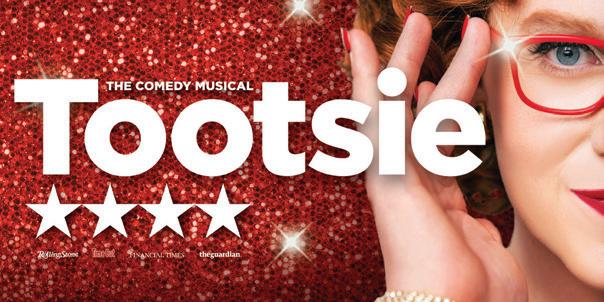

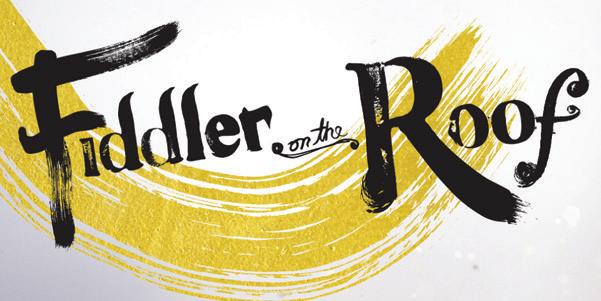
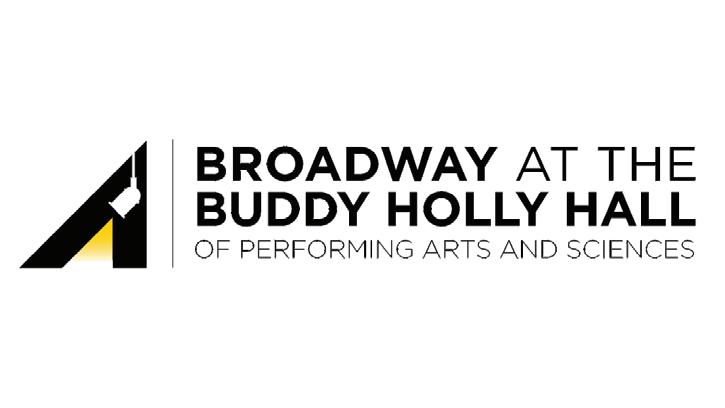




played with a brass mouthpiece, the serpent changes pitch by the means of tone holes and a system of keys similar to a flute or clarinet. It can be heard in a few eighteenth-century compositions, most notably in Handel’s Music for His Majesty’s Royal Fireworks from 1749. It is said that upon first hearing the instrument and being told its name, Handel quipped, “Aye, but not the serpent that first seduced Eve.” The great eighteenth-century British musical writer Charles Burney was less complimentary when he wrote “The Serpent is not only overblown and detestably out of tune, but exactly resembling in tone that of a great hungry, or rather angry Essex calf.” Notorious for being difficult to play in tune, the serpent faded into oblivion by the middle of the next century.
With the dawn of the Industrial Revolution at the beginning of the nineteenth century, instrument manufacturers developed alternatives to the serpent, most notably the ophicleide, heard in Berlioz’ Symphonie Fantastique and Mendelssohn’s Midsummer Night’s Dream music. Constructed of brass and played with a brass mouthpiece, it has a shape that seems to be a cross between a bassoon and a baritone saxophone, though it preceded the latter instrument by nearly thirty years. Like the serpent, pitch is changed by a woodwind-type system of keys and levers. Other variants, such as the Italian cimbasso, sprang up during the nineteenth century and faded just as quickly. With Heinrich Stötzel’s invention of the first valve mechanism for brass instruments in 1814, a whole new universe opened up for brass players and composers who wrote for them. Instead of being restricted to the notes of the overtone series (think of the notes of a valveless bugle, or a valveless hunting horn), brass instruments could now explore the entire chromatic scale, putting them on an equal melodic footing with string and woodwind instruments.
It didn’t take long for instrument manufacturers to employ this new technological breakthrough to create new brass instruments. In 1835, Wilhelm Friedrich Wieprecht and Johann Gottfried Moritz were granted Prussian Patent No. 19 for the invention of a bass tuba, which soon became the foundation for brass sections and brass ensembles all over the world. The instrument figures prominently in the works of Richard Wagner, Anton Bruckner, and Gustav Mahler, providing a rich, solid foundation to the orchestral texture. Even a composer as conservative as Johannes Brahms included the tuba in his Symphony No. 2 (1877) and his Academic Festival Overture (1881).
The evolution of the tuba as a solo instrument took a bit longer to achieve. While composers were happy to include it in every musical group from symphony orchestras to beer garden polka bands, it took nearly a century for composers to think seriously about the tuba as a recital or concerto soloist. Two groundbreaking works moved the tuba from the back of the concert stage to the front: the Concerto for Bass Tuba by Ralph Vaughan Williams which premiered in 1954, and the Sonata for Tuba and Piano by Paul Hindemith, written in 1955.
John Williams, though known throughout the world for his epic film scores for Star Wars, E.T., Raiders of the Lost Ark, and dozens more, has always had a
“I enrolled in TTU K-12 to have a more flexible schedule to practice viola so I could prepare for college auditions and participate in regional and national music festivals.”

Serving students for 30 years, TTU K-12 offers fully online solutions and alternatives for students, schools and districts!


• Award-winning, fully accredited online curriculum
• A-rated by TEA
• More than 200 online asynchronous semester-based courses
• Full-time diploma track with two options: free tuition for qualifying Texas students or tuition-based
• Individual courses and credit by exams that supplement school or homeschool curriculum
• Students can advance academically or graduate early


• Students can recover credits
LEARN MORE AT K12.TTU.EDU/LSO
keen interest in writing for the concert hall. His Tuba Concerto dates from his years as conductor of the Boston Pops Orchestra. Written as a commission for the Pops’ centenary in 1985, the work was written for Chester Schmitz, the principal tuba of the Pops and of the Boston Symphony Orchestra. The concerto received its first performance on May 7, 1985 in Boston, with Schmitz as soloist and the composer conducting the Boston Pops.
John Williams provided this brief note about the work:
I really don’t know why I wrote it—just urge and instinct. I’ve always liked the tuba and even used to play it a little. I wrote a big tuba solo for a Dick Van Dyke movie called Fitzwilly, and ever since I’ve kept composing for it—it’s such an agile instrument, like a huge cornet. I’ve also put passages in for some of my pets in the orchestra—solos for the flute and English horn, for the horn quartet and a trio of trumpets. It’s light and tuneful and I hope it has enough events in it to make it fun.
The work is in three movements, played without pause. The opening is a sprightly dance in 12/8 meter, with the soloist exploring the wide range of the instrument from the first entrance. The movement abounds with echoes of the composer’s film music and with technical difficulties for the soloist, especially in the solo cadenza towards the end of the movement. The lyrical second movement evokes the sound world of another film composer, Malcolm Arnold, with its unquiet atmosphere of eerie shimmering strings and its improvisatory solos for English horn and flute. A bright fanfare from brass and percussion ushers in the final movement, which dances with frenetic energy, hinting at both the finale of the Vaughan Williams’ Tuba Concerto and to the composer’s score for The Witches of Eastwick. The work concludes in devilish high spirits, the concluding fanfare bristling with spicy Stravinskian harmonies.
Antonín Dvořák: Symphony No. 9 in E minor, Op. 95, “From the New World”
In 1891, Antonín Dvořák received an offer from the New York socialite Jeanette Thurber to come to the United States and become the Director of the National Conservatory of Music in New York City for the (at that time) lavish salary of $15,000 per year. In his tenure in New York (1892-1895), Dvořák met and taught young American musicians, including the African-American composer Harry Burleigh (1866-1949) who introduced him to spirituals and other music indigenous to America.
The music he heard through Burleigh and others bore marked similarities to the folk music of his own Bohemian homeland. In writing about the melodies of indigenous American music, Dvořák said:
“…These can be the foundation of a serious and original school of composition, to be developed in the United States. These beautiful and varied themes are the product of the soil. They are the folk songs of America and your composers must turn to them.”
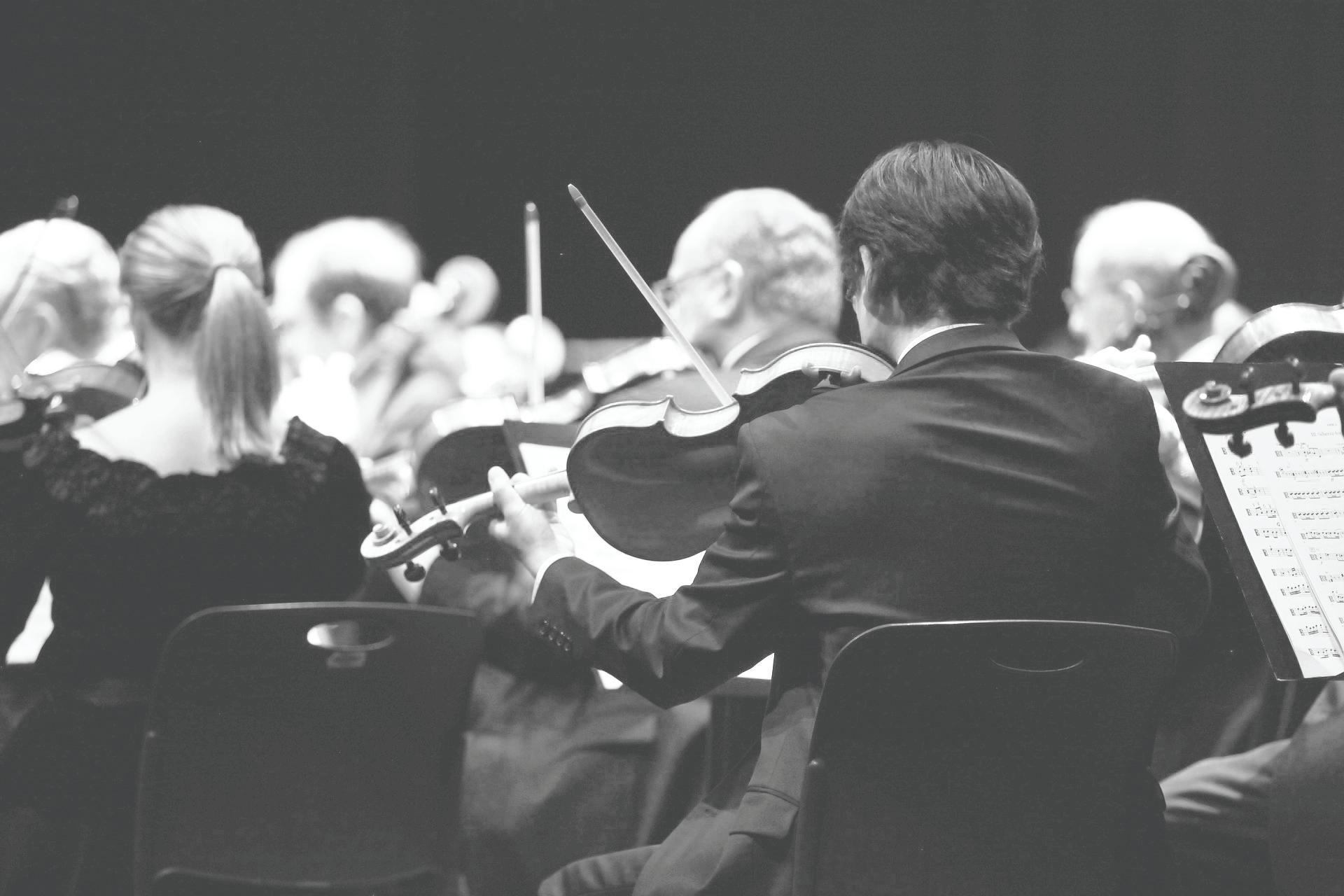

The Lubbock Symphony Orchestra would like to express gratitude to
Dvořák spent his winters in New York, but his summers in the Czech immigrant community of Spillville, Iowa, where some of his cousins had settled several years earlier. Surrounded by people who spoke his language, Dvořák felt at home enough to write music both inspired by the United States (the American Quartet, Op. 96, the Sonatina for violin and piano, Op. 100) and reminiscent of his homeland (the magnificent String Quintet in E-flat major, Op. 97 and the Cello Concerto). Eventually a dispute over salary and the potential for greater fame in Europe enticed Dvořák to return home to Prague, where he became Director of the Conservatory there from 1901 until his death in 1904.
The Symphony No. 9 in E minor, Op. 95, “From the New World,” was composed in the winter and spring of 1893 in New York on a commission from the New York Philharmonic Society. Anton Seidl conducted its first performance in Carnegie Hall on December 16, 1893. Rapturous applause broke out at the conclusion of each movement. Dvořák felt obliged to stand and acknowledge the acclaim; as he wrote to his publisher Simrock, the applause continued long enough that there was “no getting out of it, and I had to show myself willy-nilly.”
The inspiration and character of the melodies of the “New World” Symphony have been the subject of debate from the first performance onwards. Some musicologists claimed that Dvořák had included the melodies of spirituals and Native American music into the work, but the composer refuted this idea:
“I have not actually used any of the [Native American] melodies. I have simply written original themes embodying the peculiarities of the Indian music, and, using these themes as subjects, have developed them with all the resources of modern rhythms, counterpoint, and orchestral color.”
He went on to mention that the Largo second movement was a preliminary work that would be expanded into a cantata or opera based upon Henry Wadsworth Longfellow’s The Song of Hiawatha; for whatever reason, that project was never realized. Dvořák also indicated that the scene at Hiawatha’s feast “where the Indians dance” inspired the canonic melody of the Scherzo. Pentatonic melodies abound throughout the opening movement as well: the arpeggiated horn call hinted at in the introduction and expanded into the principal theme of the movement, the second theme, heard in the low register of the flutes, and the exposition’s closing theme, in which some commentators have found echoes of the spiritual “Swing Low, Sweet Chariot.”
In listening to the work without explanation, the melodic character seems as Czech as it is American. It is interesting that Dvořák chose the title “From (as opposed to “Of”) the New World” – perhaps an acknowledgement that the work is more a palimpsest of American music on the imagination of a Czech composer rather than a specifically American symphony.


The work is cyclical in structure: the main themes from the opening movement (the Allegro’s initial horn call and the second theme heard on the solo flute) appear throughout the work, as do both the opening chorale and English horn melody from the Largo. Yet for all of the symphony’s Romantic and folk-like influences, it retains the structure of the fourmovement Classical symphony: the first movement is a textbook sonataform movement, complete with exposition repeat. The slow movement is notable for both its serenely beautiful English horn melody but also for the climactic appearance of music from the first movement just before the English horn returns. While the scherzo’s pentatonic melodies contain the hint of an American accent, the melodies of the central trio section could easily be mistaken for music from the composer’s two sets of Slavonic Dances. The finale unleashes a huge burst of orchestral energy, begun by the strings and then taken over by horns and trumpets. Themes from previous movements return, leading to the final tragic-triumphant peroration and the questioning final chord.

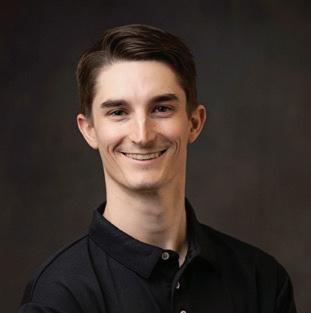
texastechalumni.org



MAESTRO’S Gold CIRCLE
($15,000+)
Herb Armstrong and Evan Sabino
Harold and Deena Evensky
Hill & Ioppolo Oral & Dental Implant
Surgery of Lubbock
Neil and Sandra Kurtzman
Don and Jan Ledbetter
Lola and Thomas Windisch
MAESTRO’S SILVER CIRCLE
($7,500 – $14,999)
Norton and Jane Baker
Dolle Barker
GRACO Real Estate Development, Inc.
Curtis Griffith
Mr. and Mrs. Joe Horkey
Adrian and Leslie Huckabee
Craig and Ann McDonald
Lee and Beth Pennington
Toni E. Wallingford
MAESTRO’S CIRCLE
($5,000 – $7,499)
Joan Baker
Jill and Gilbert Berdine
Dr. Mounir and Mrs. Leen Borno
RADM and Mrs. Stephen Chadwick
David Cho
Thivakorn and Betsy Kasemsri
Don and Susan Maddox
Jo Anne M. Smith
Virtuoso’s CIRCLE
($3,500 – $4,999)
Michael Epps
Sandy and Alan Henry
CONCERTMASTER’S CIRCLE
($1,500 – $3,499)
Stephen and Maria Balch
Mark and Betsy Bass
Ray and Cathy Box
Deborah Conn
Patty D’Alise
Stephen and Kathy Faulk
Elias and Eleonora Ghandour
Brad and Birgit Green
Elgin and Erin Gregg
Dr. and Mrs. Jack and Jane Henry
Mark and Heather Hocker
John and Cherie Hunter
Robert and Stacey Kollman
Larry and Lucy Landusky
Kurt and Paula Loveless
Jim and Patti Lupton
Rick and Sharon Martin
Mallory Miller
Mary Moran
Judy and Gary Poffenbarger
John and Katie Salter
James and Shanna St. Clair
Steve and Robin Talbert
Dr. and Mrs. Davor Vugrin
Mr. Jon Walter
Dr. Charles and Pat Wheeler
($1,000 – $1,499)
Dwight Andrews
Dustin Baucom
Blayne Beal and Monty Long
Mr. Anthony and Dr. Helen Brittin
Terri and Mike Byrne
Noelle Zavala
Amy Grisham
Mr. David Harmon
Karen and Mark Havins
Tommy and Lavelle Hawkins
Ross and Kelli Hilburn
Sidney Hopper
Ms. Bobbye Hrncirik
Alena Ilyushyna
Carol King
Mr. and Mrs. Robert Lin
Drs. Barent and Audrey McCool
Peggy and Terry McInturff
Ms. Amanda Mead
Family Owned Since 1931



Curtis and Brenda Parrish
Melissa and Tim Pridmore
Keli Ramsey
Judy Rowdon
Tim and Mary Jane Sampson
Kevin and Carrie Sedberry
Nancy Sharp
Dr. Phil Sizer
Jill and Fred Stangl
Brian A. Willcutt
($500 - $999)
Pieter Bergstein
Aubrey and Ruth Ann Bridges
Bryan Camp and Susan Gillette
Mrs. Bobbe Crawford
Sara and Tim Dodd
Joan and Joe Dominey
Mr. Stephen G. Fannin
Dr. Bess Haley
Dennis and Ellen Harp
Janeen Drew Holmes
Don and Lynnita Hufstedler
Dr. Cynthia Jumper and Dr. Reid Norman
Morris and Janice Knox
Ms. Mary McCrary
Sally Murray
Tom and Sarah Parsons
Mrs. Dona Richardson
Tommy and Tina Sansom
Sam and Jana Scheef
George and Judy Sell
Melanie Sorsby
Sandra Stratton
($275 - $499)
Alexis Anderson
Matthew and Krista Bumstead
Mary Cato
Richard and Reyhan Crider
Bob and Sandy Crosier
P.D. and Gayle Cunningham
Jim and Patti Douglass
Drs. Robert Duncan and Annette Sobel
Giles and Lynn Forbess
Claudia and Mark Griffin
David Hodges
Honorable and Mrs. Phil Johnson
Mr. Robert Jokisch
John Jones
Randy Kinnison and Jane Rowley
Wyatt and Claire Leavell
Melissa Lewis
Ms. Sara McLarty
Linda and George McMahan
Laura and Monte Monroe
Davis and Janet Price
Mike and Melanie Ragain
Kelly Robinson
Karen Savage
Betty Wall
Jenny and Edson Way
Jimmy and Susan Wedel
Dr. and Mrs. Hugh Wilson
Debby and Dennis Zuehlke
($125 - $274)
James Arnold
Ian and Shelley Barba
Edward Broome
Robb Chapman and Dr. Sarah Hosford
Dr. Hua Chen, Dr. Grace Sun and Family
Barry Cohen
Charles Croessmann
Carol Daugherty
David and Claudia Dea
Keith A. Gray
Marion Hagler
William and Janis Hartwell
Terry Hawkins and Doug Klepper
Mr. Larry Hess
Shyrle Hill
Dr. Catherine Jai
Brian Kendall
Lucy Lanotte
Brad and Carol Ann Layton
Wendell Leatherwood
Eric Lee
Shannon McClendon
Jill Nelson
Tom and Gwen Nichols
Norman and Bettie Orr



Trois Payne
Dr. Gregory and Betty Pepetone
Gerald Pipkin
Susan Pollard
Carolanne and Jim Purtell
Peter Reed
Lynn Schmidt
Melanie Slaton
Janice Stachowiak
Stephanie Starkovich
Steve Synck
Tom Tenner
Jack Thompson

Kathleen Turner
Tim and Amanda Wooten

Mrs. Gay Word
Ms. Martha York
John and Ann Zwiacher







The Lubbock Symphony Orchestra respectfully acknowledges donations received during the 2022-2023 season in honor of the following:
Memorials:
Milton Bagwell
Blake Eddie Bingham
Dr. Eugene Dabezies
Lou Dunn Diekemper
Mary Epps
David and Beebe Fields
John Charles Fox III
Justin Andrew Fregia
H.E. Prince Bira Kasemsri
Shelley Furr Nelson
Ricky Rasco
Herb Tavenner
Honorariums:
Kea Beasley
Annie Chalex Boyle
David Cho
Reyhan and Richard Crider
Joan and Frank DeCelie
CJ Goodyear
The Harrod Family
Lynnita Hufstedler
Larry Landusky
Terry and Peggy McInturff
Galen Wixson
Toni Wallingford
Kalitsa and George Zias
If you would like to honor an individual or organization important to you, please send your tax-deductible donation to the Lubbock Symphony Orchestra, 601 Avenue K; Lubbock, TX 79401.
The Lubbock Symphony Orchestra Endowment Trust
The CH Foundation Conductor’s Podium Endowment
Helen DeVitt Jones Endowment for Education
LSO Endowment for Musician Fees and Education
Shelley Hall Nelson Endowment for Musicians’ Salaries
Lubbock Symphony Opera Fund
Texas Tech University J.T. & Margaret Talkington College of Visual and Performing Arts, School of Music Performer Endowment
Jones-Saathoff Family Concertmaster Endowment
Diekemper Family Foundation Associate Concertmaster Endowment
Justice Phil and Carla Johnson Principal Second Violin Endowment
Mary M. Epps and Ralph E. Wallingford Principal Viola Endowment
Mary Francis Carter Principal Cello Endowment
Eugene and Covar Dabezies Principal Bass Endowment
Drs. Audrey and Barry McCool Principal Flute Endowment, in memory of the Crew of Columbia, STS-107
Lubbock Symphony Guild Principal Oboe Endowment
Janeen Drew Holmes English Horn Endowment
Christine Polvado and John Stockdale Principal Clarinet Endowment
Nancy and Tom Neal Principal Bassoon Endowment
Anthony and Helen Brittin Principal Horn Endowment
Stacey and Robert Kollman Family Principal Trumpet Endowment
Larry and Lucy Landusky Principal Trombone Endowment
Tim and Mary Jane Sampson Bass Trombone Endowment
Diekemper Family Foundation Principal Tuba Endowment
Lubbock Symphony Guild Timpani Endowment
Lisa Rogers/Alan Shinn Principal Percussion Endowment
Rachel Jean Armstrong Thomas Principal Harp Endowment
Edward R. and Jo Anne M. Smith Principal Piano Endowment

Jack M. Lewis
W.P. Clement
Charles E. Maedgen, Jr.
Roy Bass
Rex Webster
Marion Key
W.R. Sewell
J.C. Reynold
James L. Quicksall, Jr.
Asher Thompson
Richard G. Richards
Jack Kastman
Joe J. Moise
J. Harmon Jenkins
George C. Miller
Lonnie Langston
John Witcomb
O.W. English
Asher Thompson
Troy Myers
Arthur E. Gamble
Charley Pope
C.B. Carter
Robert E. Norris
Dean James Allen
Robert L. Stripling
Charley Pope
John R. Kreiger
Roger Key
Edwin E. Merriman
Owen McWhorter, Jr.
Frank Newton
Frank Anderson
Kay Sanford
Paul Meyer
Robert L. Stripling
Jim Ratliff
Coffee Conner
Alan Henry
William D. Armstrong
Susan Boling
Curtis Griffith
DeWayne Pierce
Mike Cunningham
Margaret Lutherer
Chris Barnette
Catherine S. Porter
Ray Fargason
Emily Ratcliff
Brad Green
Peter G. Daia
Kirk McLaughlin
Harry Zimmerman
Shannon Taliaferro
Heather Hocker
LSO is grateful for the generous support of the following foundation, community, and public partners.
Affordable Storage
Alan Henry Insurance
ALLIANCE Credit Union
All Saints Episcopal School
Anderson Bros Jewelers
Atmos Energy
Ballet Lubbock
Benchmark
Betenbough Homes
Bolinger, Segars, Gilbert & Moss, LLP
Brandon Guitar Studio
Bruckner Society of America
Carillon
Chicken Express
City Bank
Cleaning Services of Lubbock
Community Foundation of West Texas
Covenant Health
CRI
Diekemper Family Foundation
D. Williams & Co.
Drest by Scott Malouf
Evelyn M. Davies Foundation
Evensky & Katz Wealth Management
Farnsworth Family Orthodontics
First United Methodist Church
Ghandour, Elias M.D., P.A.


GRACO Real Estate Development, Inc.
Happy State Bank
HCHT
Helen Jones Foundation
Hill & Ioppolo Oral & Dental Implant Surgery of Lubbock
JF Maddox Foundation
KCBD
Kingsgate Center (Graco Real Estate)
KTTZ 89.1 FM
Kuykendall Foundation
La Posta Botique
Lee Lewis
Llano Estacado Winery
Lone Star State Bank
Louise Hopkins Underwood Center for the Arts
Lubbock Abstract & Title Co
Lubbock Animal Care Clinic
Lubbock Arts Alliance
Lubbock Avalanche-Journal
Lubbock Chorale
Lubbock Community Theatre
Lubbock Entertainment
Performing Arts Association
Lubbock Moonlight Musicals
Lubbock Music Club
Lubbock Music Teachers Association
Lubbock National Bank
McPherson Cellars
Merrill Lynch
MS Doss Foundation
MWM Architects, Inc.
Officewise Commercial Interiors
Orlando’s Italian Restaurant
Otto’s Granary
Overhead Door Co.
Overton Hotel
Parkhill, Smith & Cooper
PayPal
Pediatric Associates of Lubbock
Pennington, Bass & Associates
Phi Beta Kappa Assn. of West
Texas & Eastern New Mexico
Endowment to Benefit
LSO Youth Outreach
Pinkie’s Plains Capital Bank
Prosperity Bank
Rea Charitable Trust
Robinson & Hamblen General Dentistry
Sanders Funeral Home Service Title
Sharon Mirll, Exit Realty
Sherick Memorial Home
South Plains College
Southwest Snow Services
Spec’s
St. Clair & Massey Orthodontics
Stewart Title
Tarpley Music
Texas Commission on the Arts
Texas Tech Alumni Association
Texas Tech Club
Texas Tech School of Music
Texas Tech University Presidential Lecture & Performance Series
Texas Women for the Arts
The CH Foundation
Tif Holmes Photography
T L C E Charitable Fund
TTU eLearning
TTU Talkington College of Visual and Performing Arts
TTU Theatre and Dance
United Supermarkets University Medical Center
Yellow House Dental & Implant Center
Youth Orchestras of Lubbock
YWCA


Brian Willcutt Chair
Toni E. Wallingford
Chair Elect
Katie Salter Treasurer
Terri Byrne Secretary
Heather Hocker
Immediate Past Chair
Steve Balch
Dolle Barker
Dustin Baucom
Gilbert Berdine
Leen Borno
David Cho
Patty D’Alise
Michael Epps
Stephen Faulk
Elias Ghandour
Gurdev Gill
Matt Grannan
Brad Green
Erin Gregg
Amy Grisham
Sandy Henry
Bobbye Hrncirik
Leslie Huckabee
Alena Ilyushyna
Tiva Kasemsri
Neil Kurtzman
Melissa Lewis
Paula Loveless
Amanda Mead
Barry McCool
Mallory Miller
Brenda Parrish
Judy Poffenbarger
Melissa Pridmore
Peter Reed
Abi Rhoades
Tim Sampson
Phil Sizer
Andrew Stetson
Robin Talbert
Davor Vugrin
Pat Wheeler
Lola Windisch
Galen Wixson
Galen Wixson
President & CEO
David Cho
Music Director
Mason Webb
Box Office & Education Coordinator
Emily Gavaghan
Director of Marketing
Amelia Jamieson
Graphic Designer
Corey Dolter
Operations Manager
Gary Hudson
Personnel Manager
Leslie Breslin
Director of Development
Kea Beasley
Director of Education
Suzanne Rasco
Director of Accounting
Vaughan Hennen
Librarian
Callie Watson
Graphic Design Intern
Jordan Parks
Marketing Intern
Anterian Gee
Marketing Intern
Rachel Vickery
Librarian Intern


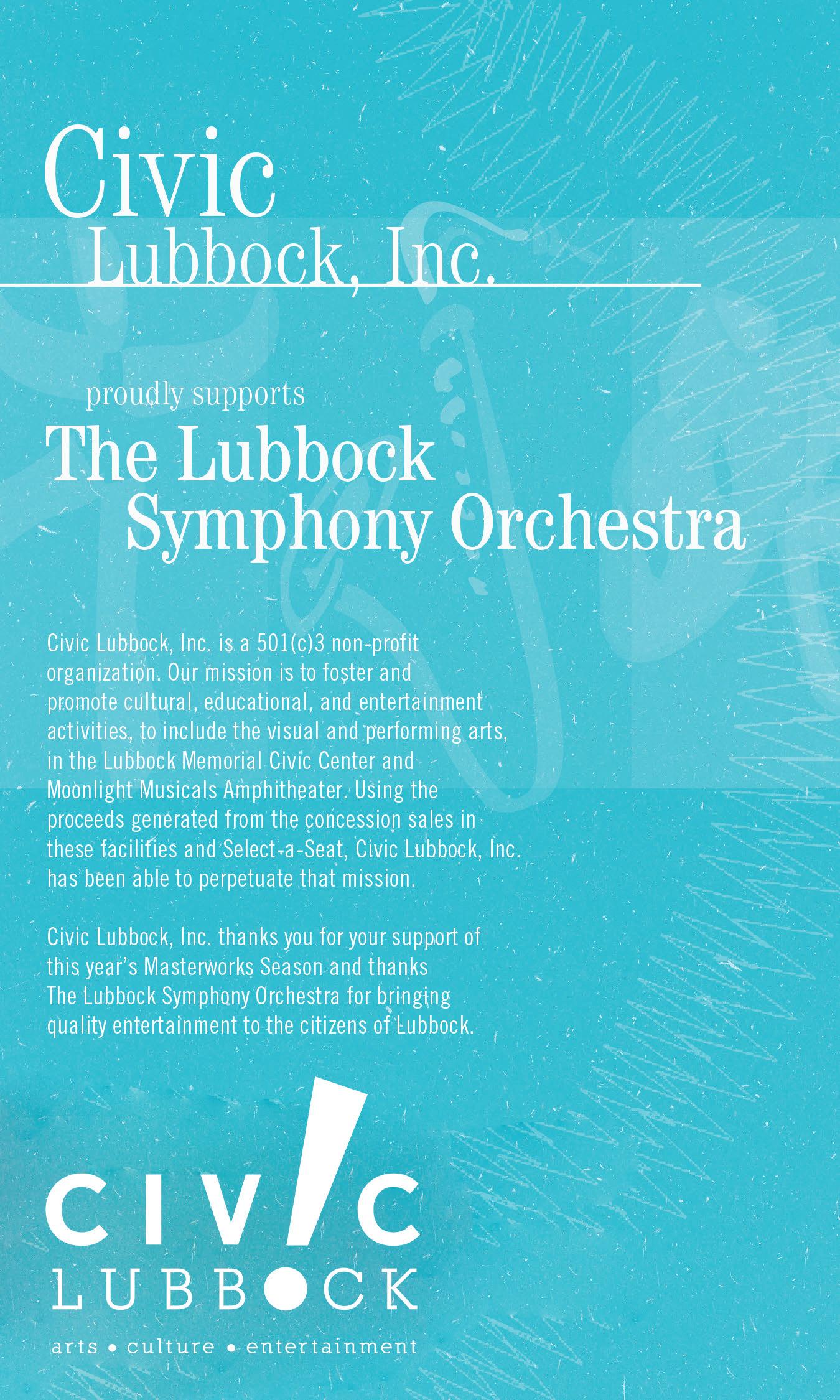

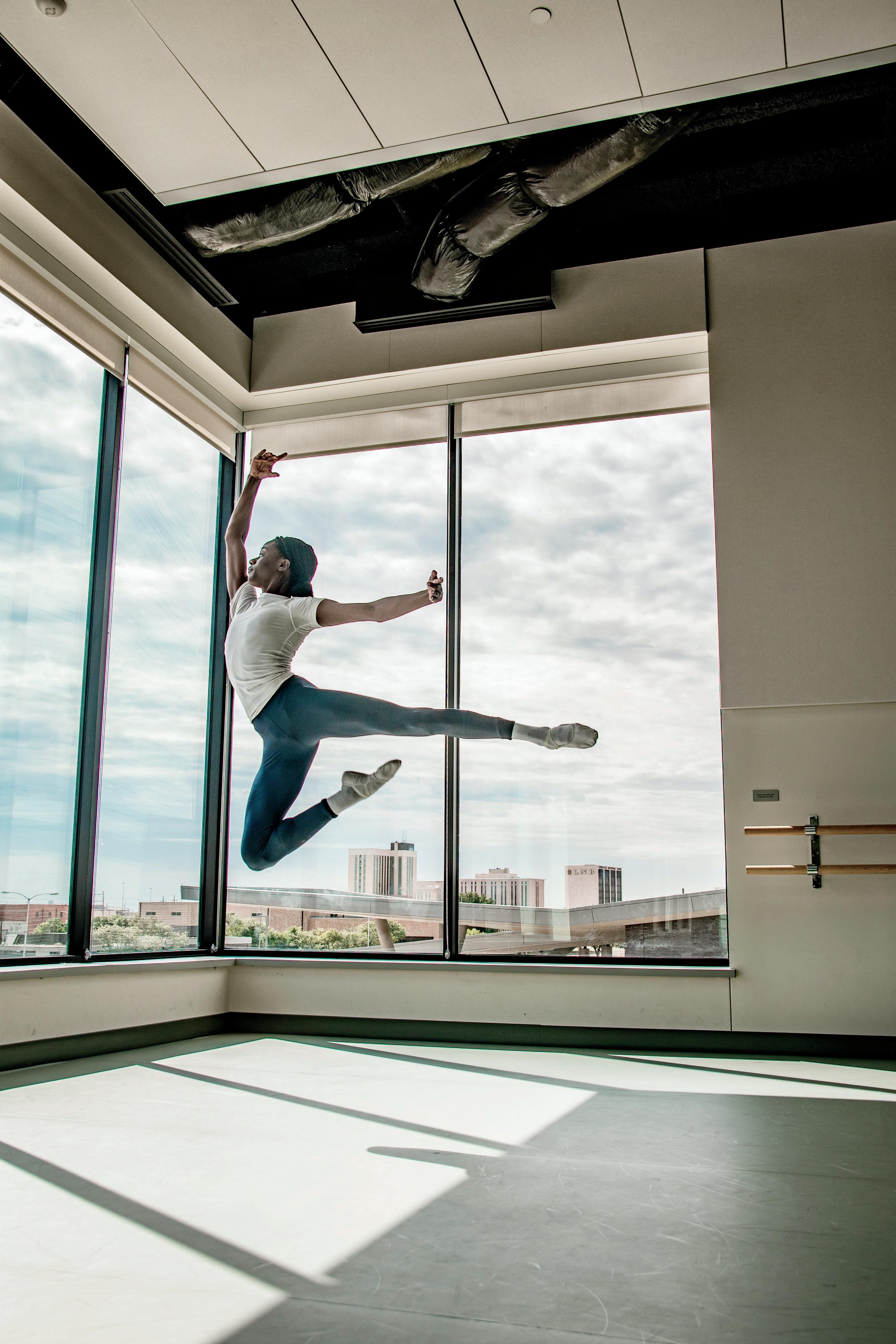



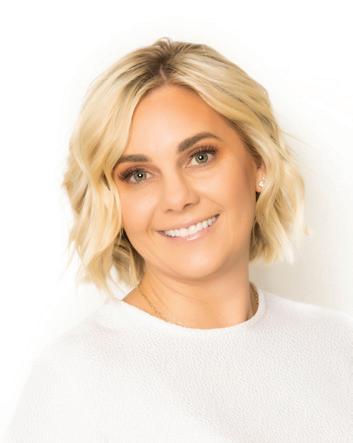
Thank you for attending tonight’s performance! We appreciate your support of the Lubbock Symphony Orchestra. The 2022-2023 “Symphonic Scenes” season promises to be outstanding. We are so excited to experience the wonder of music with you.
Tonight’s performance, and every performance since 1952, has been made possible in part by the Lubbock Symphony Guild. For 70 years, the Guild members have donated their time and resources to keep symphonic music thriving in West Texas.
I hope you enjoy the incredible talent of our remarkable Orchestra and value the educational and cultural contributions they provide to our community. I invite you to consider becoming a member of our Lubbock Symphony Guild. For more information, please visit our website at www.

Front Row Left to Right - Madeline Matthews, Emily Keister, Tatum Brown, Payton Harrison, Katherine White
2nd Row Left to Right - Maggi Underwood, Portia Clary, Madison Bigham, Anna McClendon, Blakely Biggs, Abby Harris
3rd Row Left to Right - Sydney Cranfill, Ava Hounshell, Sydney Lowe, Halle Henthorn, Ashtyn Bartley, Kaitlyn Caswell
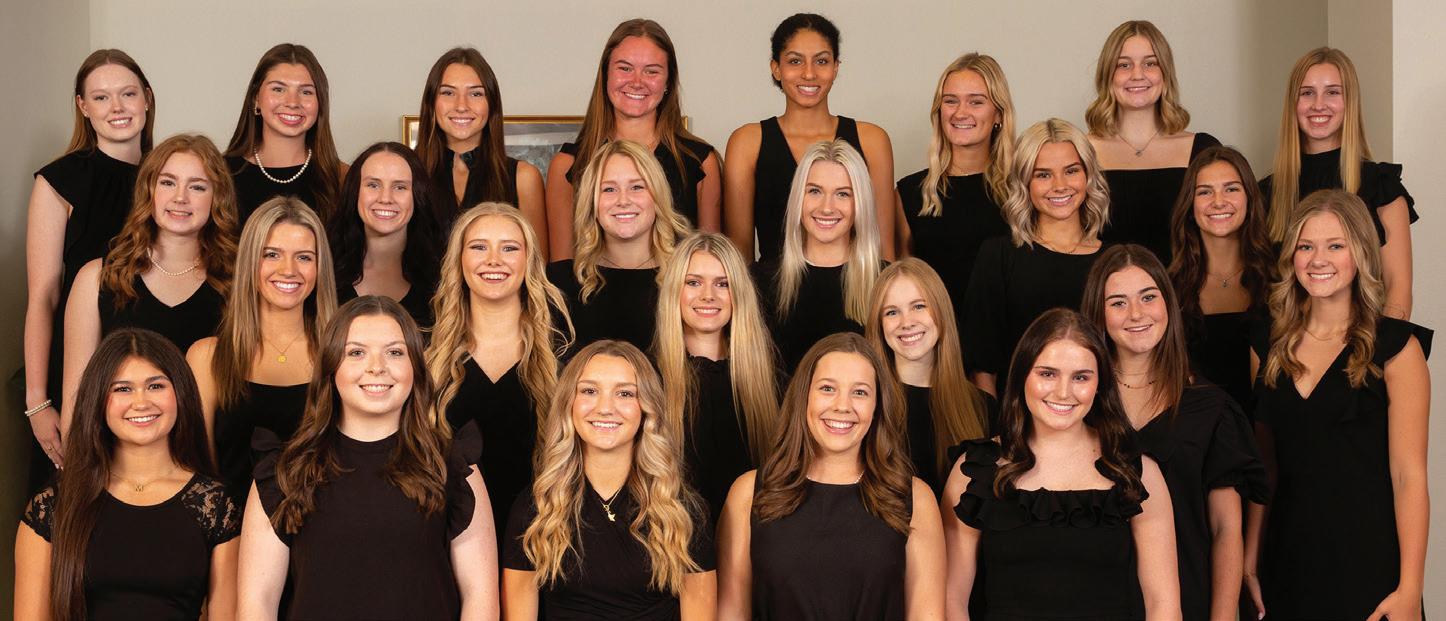
Back Row Left to Right - Macy Hamel, Abigail St Clair, Emily Payne, Kathryn Kinnison, Chloe Conover, Elizabeth Kinnison, Natalie Caswell, Campbell Howe
Not Pictured -Regan Andrews, Adisyn Elrod, Ellis Fox, MaeAlice White
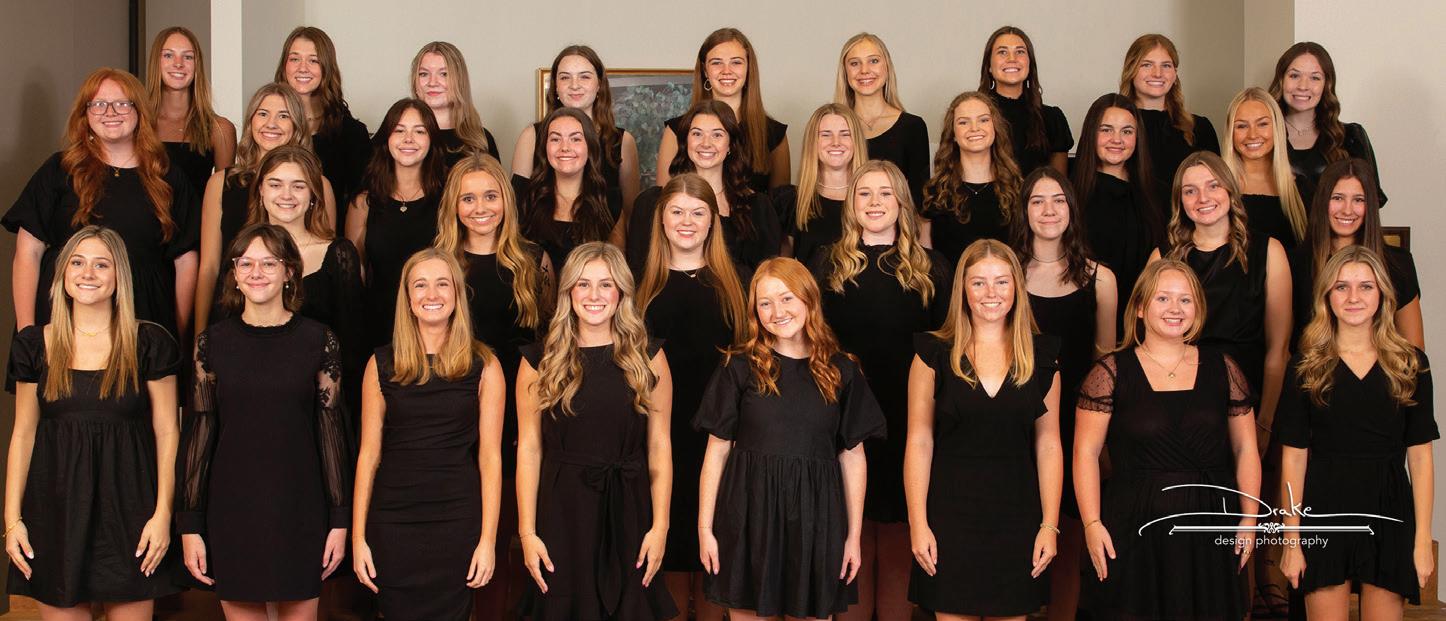
Front Row Left to Right - Alayna Bayouth, Hannah Feist, Kathryn Kothmann, Addison Burnett, Avery Schilling, Emme Hocker, Anna Everett, Jessica Foley
2nd Row Left to Right - Jillian Jones, Annabelle Bennett, AbiGayle Mills, Ava Campbell, Claudia Tepper, Campbell Carper, Reghan Rose
3rd Row Left to Right - Ava Lansdell, Skylar Tidwell, Emma Feist, Preslie Tarver, Berkley Bird, Olivia Needham, Christiana McCourt, Kathryn Cardelli, Jewel Naegele
Back Row Left to Right - Ella Scolaro, Mya Ballou, Lydia Carter, Alexandra Dannemiller, Madison White, Jeye Johnson, Olivia Phillips, Mia Capodagli, Kennedy Venable
Not Pictured - Kendall Cathey, Hannah Cooper, Preslee Edwards, Amelia Rodriquez, Emeri Tran

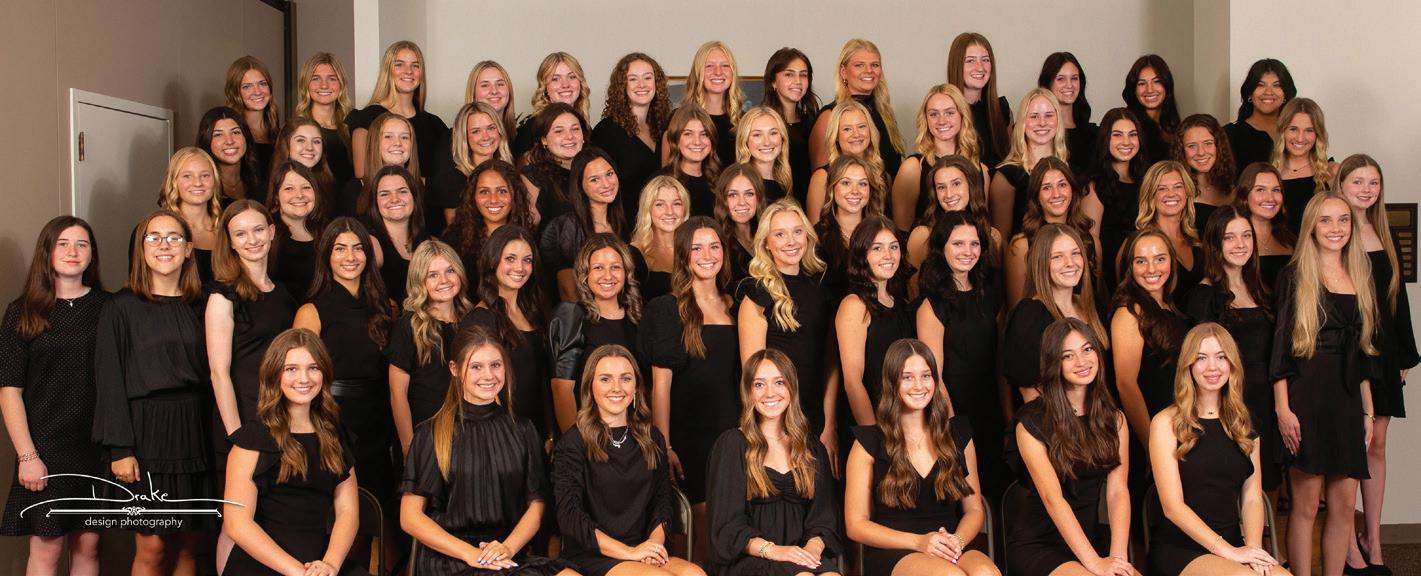

Front Row Left to Right - ALondon Carlisle, Brentley Preston, Tierni Green, Ryann Grissom, Emory McCain, Ella Mendez, Emily Roark

2nd Row Left to Right - Ashlyn Simek, Kamryn Chandler, Claire Ancell, Maya Al-Hmoud, Sadie Callison, Camden McDougal, Jayci Lentz, Addison Kitten, Rylan Belle Raley, Olivia Elliott, Reece Watson, Taylor Harrison, Anne Edwards, Grace Gerwig, Aubrey White
3rd Row Left to Right - Bella Lampe, Brynlee Hogg, Madelyn Caswell, Teema Sharif, Reece Riddle, Haleigh McKee, Raegan Reed, Jencee Thompson, Maya Vermillion, Rylee Rose, Hope Hancock, Ella Murphree, Lauren Casey
4th Row Left to Right - Shiloh Roach, Elizabeth Johnson, Hannah Harvey, Sydney Smothers, Morgan Parker, Blair Belew, Remington King, Zimri Buckley, Olivia Mudd, Emily White, Bradie Smith, Lydia Pesterfield, Riley Newberry
Back Row Left to Right - - Anastyn Greaser, Raegan Lee, Hannah Pharies, Cambelle Fannin, Viviana Ziegner, lndie Williams, Bryleigh Norman, Kristen Mitchell, Ella Grace Bennett, Cora Clifford, Camryn Howe, Mia Chacon, Gabrielle Scherpereel
Not Pictured - Emma Claire Womble
